Grace Robert. Advanced Blowout and Well Control
Подождите немного. Документ загружается.


386
fire.
Very large well fires were extinguished in just minutes. Figure
17
illustrates the use
of
the fire monitors
to
extinguish
a
fire.
Advanced
Blowout
and
Well
Control
Figure
I7
Some
of
the
teams
used fire suppressant materials and chemicals
to
effectively extinguish the fires and
minimize
their water requirements.
A much broader use
of
these materials would have more effectively
conserved the precious water supplies.
Nitrogen
Prior
to
the availability
of
the required volumes
of
water, many
fires were extinguished using nitrogen. A 40-foot chimney attached to the
end of
an
Athey
Wagon
was placed over the fire, causing the flow
to
be
directed up through the chimney. The fire then burned
only
out of the top
of
the chimney. Nitrogen
was
then injected into the chimney through
an
inlet
at the base.
A
typical chimney is shown in Figure
17.
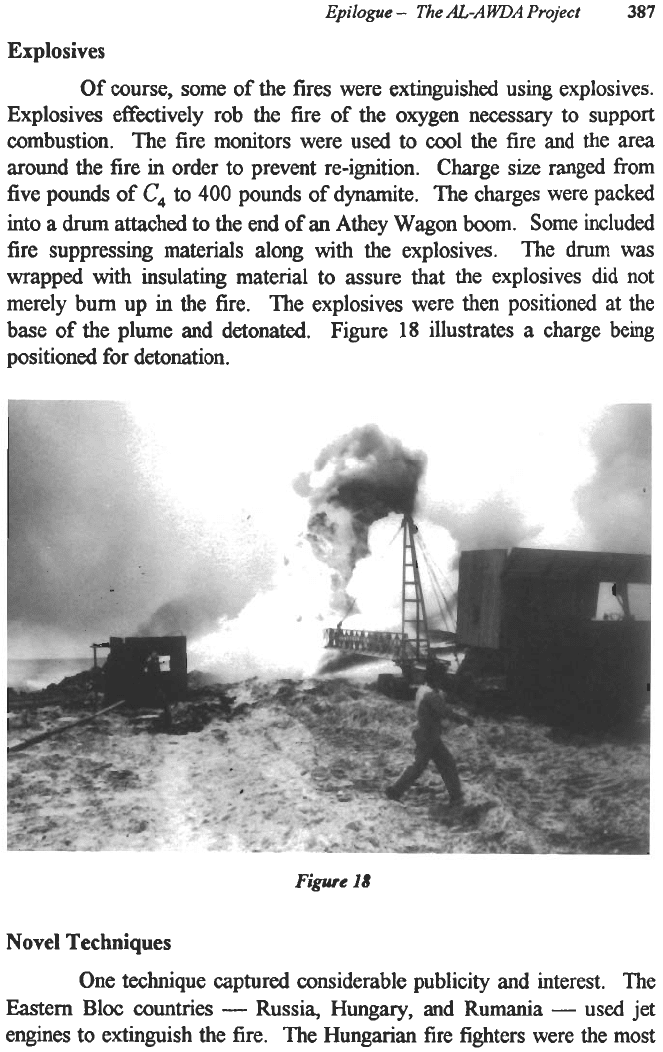
Epilogue
-
The
ALAKDA
Pmject
387
Explosives
Of
course,
some of the fires were extinguished
using
explosives.
Explosives effectively rob the fire of the oxygen necessary
to
support
combustion. The fire monitors were
used
to
cool
the fire and the area
around the fire in order to prevent re-ignition.
Charge
size
ranged from
five pounds of
C4
to
400
pounds of dynamite. The charges were packed
into a
drum
attached
to
the end
of
an Athey Wagon
boom.
Some included
fire suppressing
materials
along with the explosives. The
drum
was
wrapped with insulating material to assure that the explosives did not
merely bum up
in
the fire. The explosives were then positioned
at
the
base of the plume and detonated. Figure
18
illustrates
a
charge being
positioned for detonation.
Figure
18
Novel Techniques
One technique
captured
considerable publicity and interest. The
Eastern
Bloc
countries
-
Russia, Hungary, and Rumania
-
used
jet
engines to extinguish the fire. The Hungarian fire fighters were the most
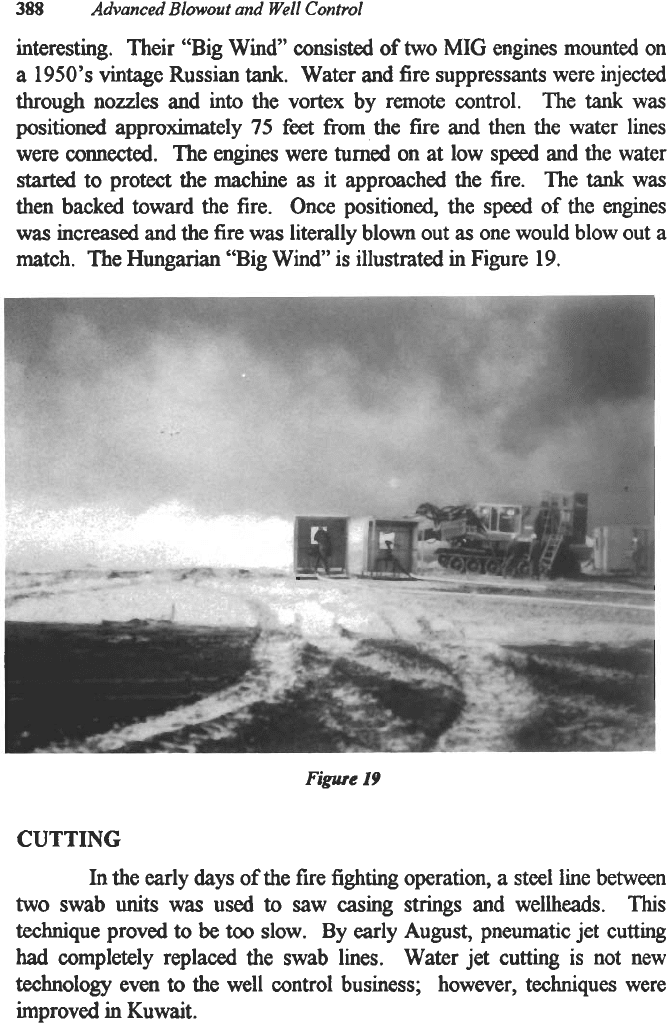
388
Advanced
Blowout
and
Well
Control
inkresting.
Their “Big Wind” consisted
of
two
MIG
engines mounted on
a
1950’s
vintage Russian
tank.
Water and fire suppressants were injected
through nozzles and into the vortex by remote control. The
tank
was
positioned approximately
75
feet
from
the
fire
and then the water lines
were connected. The engines were
turned
on
at
low
speed
and the water
started
to protect the machine
as
it approached the fire. The
tank
was
then backed toward the fire. Once positioned, the
speed
of
the engines
was
increased and the fire
was
literally blown out
as
one would blow out a
match. The Hungarian “Big
Wind”
is illustrated in Figure
19.
Figure
I9
CUTTING
In
the early days
of
the fire
fighting
operation,
a
steel line between
two
swab
units
was
used
to
saw casing
strings
and wellheads.
This
technique proved
to
be
too
slow. By early August, pneumatic
jet
cutting
had
completely replaced the swab lines. Water
jet
cutting
is
not new
technology even
to
the well control business; however, techniques were
improved
in
Kuwait.

Epilogue
-
The
A-A
WDA
Project
389
Primarily
two
systems were used in Kuwait. The most widely
used was the
36000
psi high pressure jet system using garnet sand. A
small jet was used with water
at
three
to
four gallons per minute. Most
often, the cutter ran on a track around the object
to
be cut.
In
other
instances, a hand-held gun was used, which proved to be very effective
and useful. More
than
400
wells employed
this
technique. One limitation
was that the fire had to be extinguished prior to the cut, and the cellar
prepared for men
to
~70rk safely
at
the m7ellhead. Another aspect
had
to be
evaluated before widespread use was recommended. In the dark of the
smoky skies or late in the evening, the garnet
sand
causcd sparks as it
impacted the object being cut. It was not known if under the proper
circumstances these sparks would have becn sufficient to ignite the flow.
However, re-ignition was always of concern.
Another water jet system used a 3/16
jet
on a trac or yoke
attached to the end
of
an Athey Wagon boom. The trac permitted cutting
from
one side with one jet while the yoke involved
two
jets and cut the
object from both sides. The system operated at pressures ranging between
7500
psi and 12500 psi. Gelled water with sand concentrations between
1
and
2
ppg were used to cut. The system was effective and did not require
the men to be
near
the wellhead.
In
addition, the system could be used on
burning wells, provided the object to be cut could be seen through the fire.
This technology was used on
48
wells.
Conventional
cutting
torches were used by
some.
A
chimney was
used to elevate the fire and the workers would cut around the wellhead.
Magnesium rods were also used because they offered the advantage
of
coming in 10-foot lengths that could be telescoped together.
STATISTICS
The best authorities predicted that the operation would require
five years.
It required 229 days. The project’s progress is illustrated
in
Figures
20
and 21. Originally, there were only four companies involved
in the fire fighting effort. At the beginning of August, additional
teams
were added,
making
a
total maximum
of
twenty-seven
teams
from all over
the world. The companies that participated and the number of wells
controlled by each company are
shown
in Table 3. The number of wells
controlled by each company
listed
in Table
3
is
not significant because
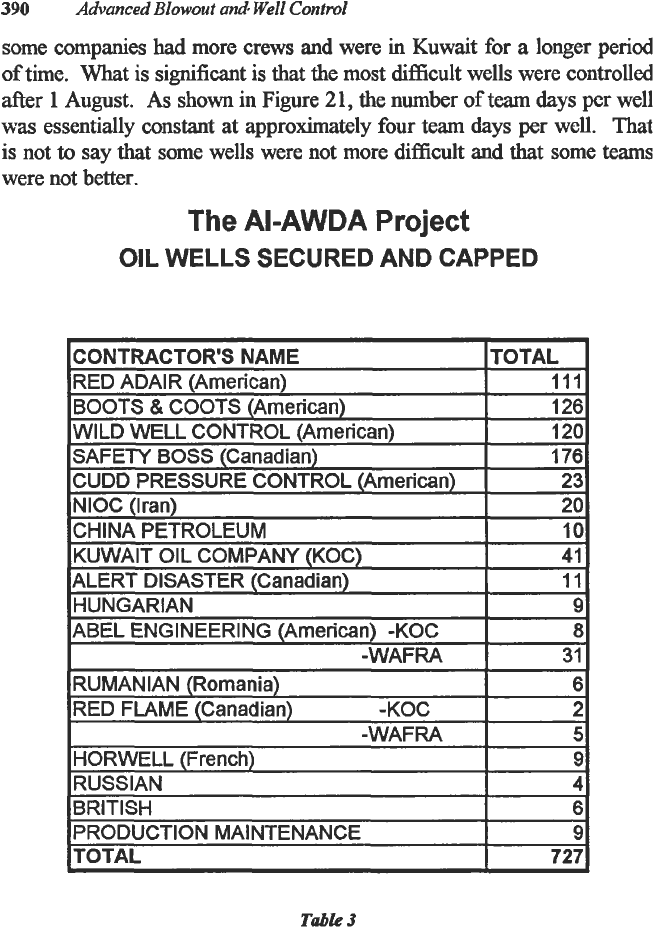
390
Advanced
Blowout
and-
Well
Control
some companies
had
more crews
and
were
in
Kuwait for a longer period
of time. What
is
significant
is
that the most difficult wells were controlled
after
1
August. As
shown
in Figure 21, the number of team days
per
well
was
essentially constant at approximately four team days per well.
That
is not
to
say that some wells were not more difficult and
that
some
teams
were not better.
The
AI-AWDA
Project
OIL WELLS SECURED AND CAPPED
PRODUCTION MAINTENANCE
TOTAL
9
727
Table
3
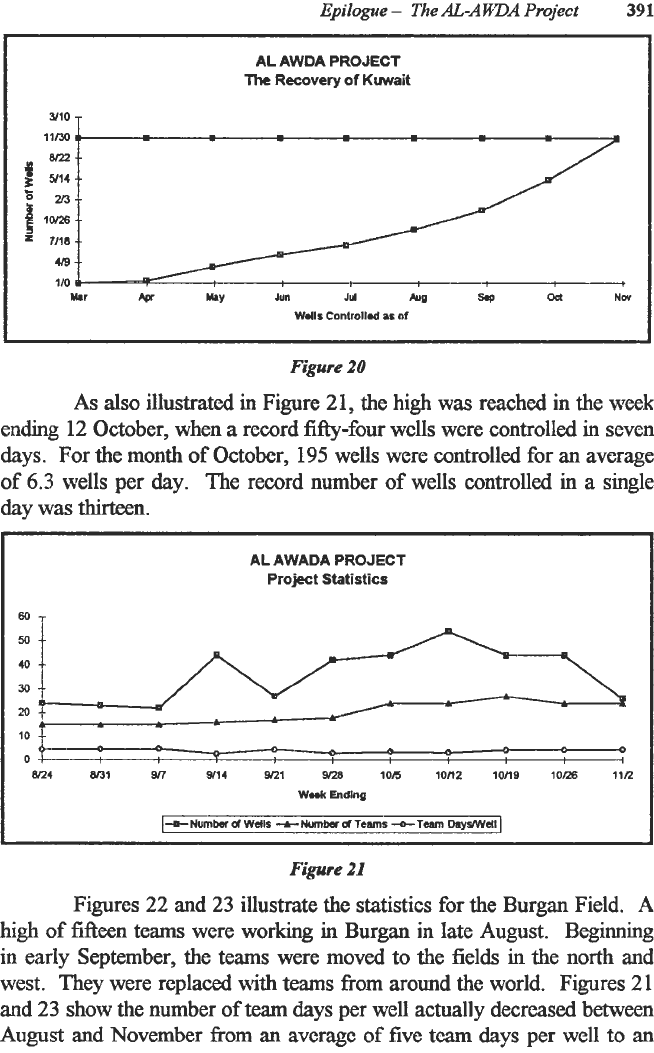
Epilogue
-
The
AL-AEDA
Project
391
AL AWDA PROJECT
The
Recovery
of
Kuwait
i
Mar
Jun
Jul
hn
-4
od
Nw
Walls ConlrolW
as
of
Figure
20
As
also
illustrated
in
Figure 21, the high was reached in the week
ending 12 October, when a record fifty-four wells were controlled
in
seven
days. For the month of October,
195
wells were controlled for
an
average
of
6.3
wells per day. The record number
of
wells controlled in a single
day was
thirteen.
AL AWADA PROJECT
Project Statistics
14-
Numk
Or
Wells
-+Number
d
Teams
-0-
Team
Day~Wdl
I
Figure
21
Figures 22
and
23
illustrate the statistics for the Burgan Field. A
high of fifteen teams were working
in
Burgan in late August. Beginning
in
early September, the teams were moved to the fields
in
the north and
west. They were replaced
with
teams from around the world. Figures
21
and 23 show the number of team days per well actually decreased between
August and November from
an
average of five team
days
per
well
to
an
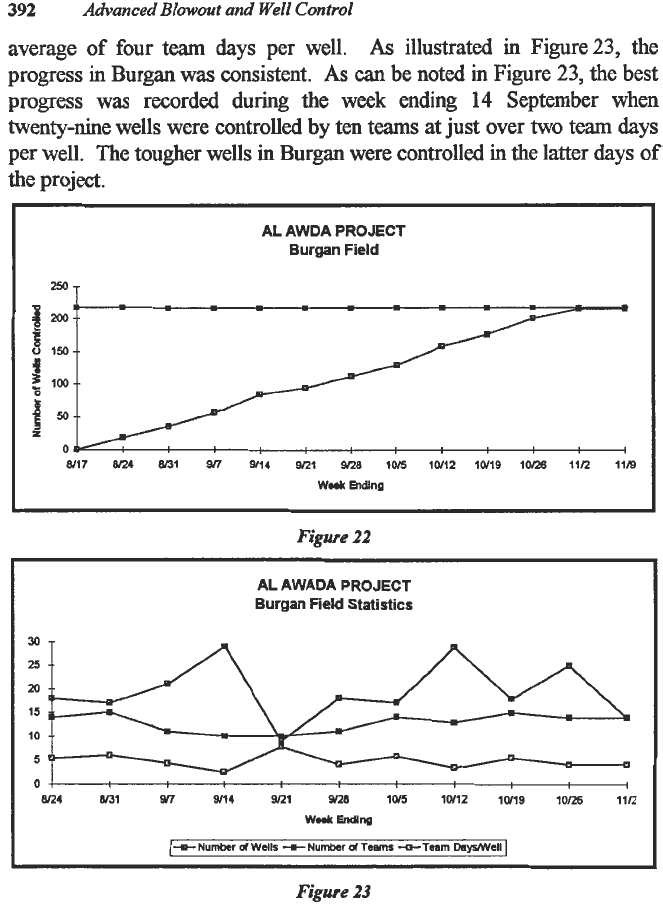
392
Advanced
Blavout
and
Well
Control
average of four team
days
per well.
As
illustrated in Figure23, the
progress
in
Burgan
was
consistent.
As
can
be noted in Figure 23, the best
progress was recorded during the week ending
14
September when
twenty-nine wells were controlled
by
ten teams at just over
two
team
days
per well. The tougher wells
in
Burgan were controlled
in
the latter
days
of
the project.
AL AWDA
PROJECT
Burgan
Field
8/17 8124 8/31
Sn
9/14 9/21
W8
1015 lW12 1Wl9 1oRB Ill2 Ill9
WWL
hung
Figure
22
AL AWADA
PROJECT
Burgan
Field
Statistics
30-
25
-I
ot
I
BR4
81J1
Sn
Sn4
9/21
9/28
1015 1W12 1Wl9 10126 Ill2
wM&
Ending
1-0-
Number
d
Wells
-n-
Number
d
Teams
-a-Taam
DayJMlell
I
Figure
23
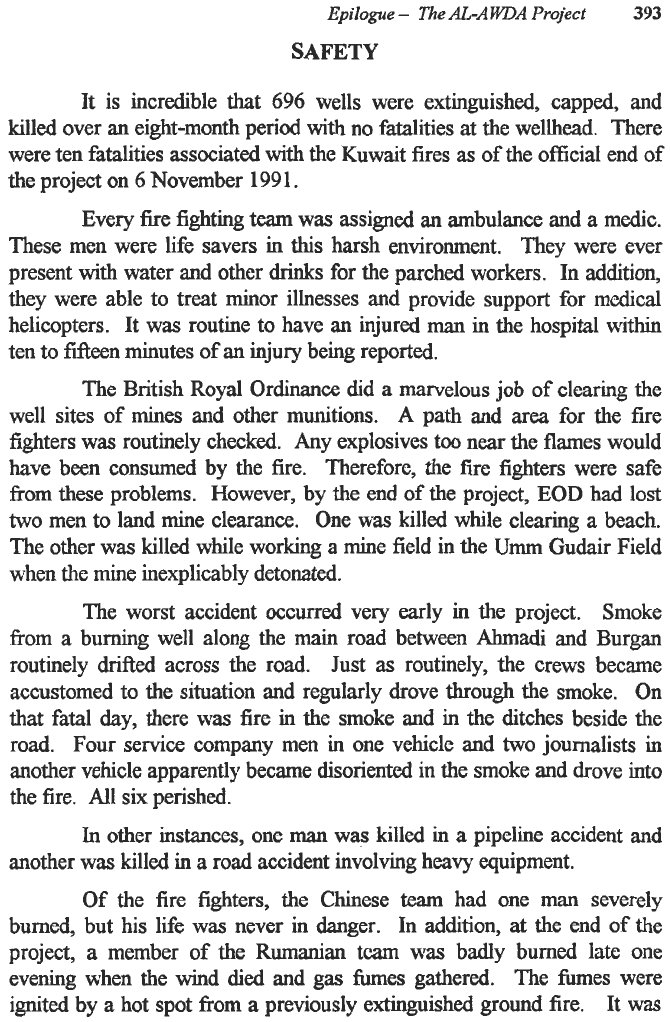
Epilogue
-
The
RC-AHDA
Project
393
SAFETY
It is incredible that
696
wells were extinguished, capped, and
killed over an eight-month period with no fatalities at the wellhead. There
were ten fatalities associated with the Kuwait fires
as
of the official end of
the project on
6
November
199
1.
Every fire fighting team was assigned an ambulance and a medic.
These men were life savers in
this
harsh environment. They were ever
present with water and other
drinks
for the parched workers. In addition,
they were able to treat minor illnesses and provide support for mcdical
helicopters. It was routine to have an injured
man
in the hospital
within
ten to fifteen minutes of an injury being reported.
The British Royal Ordinance did
a
marvelous job of clearing the
well sites of mines and other munitions.
A
path and area
for
the fire
fighters was routinely checked. Any explosives
too
near the flames would
have been consumed by the fire. Therefore, the fire fighters were safe
from these problems. However, by the end of the project,
EOD
had
lost
two
men to land mine clearance. One was killed while clearing a beach.
The other was killed while working a mine field in the
Umm
Gudair Field
when the mine inexplicably detonated.
The worst accident occurred very early
in
the project. Smoke
from
a
burning well along the main road between Ahmadi and Burgan
routinely
drifted
across the road. Just
as
routinely, the crews became
accustomed to the situation and regularly drove through the smoke. On
that fatal day, there
was
fire in the smoke and in the ditches beside the
road. Four service company men in one vehicle and
two
journalists in
another vehicle apparently became disoriented in the smoke and drove into
the fire.
All
six perished.
In
other instances, one
man
was killed in
a
pipeline accident and
another was killed in a road accident involving
heavy
equipment.
Of the fire fighters, the Chinese
team
had one man severely
burned, but his life
was
never
in
danger. In addition,
at
the end
of
the
project, a member of the Rumanian tcam
was
badly burned late one
evening when the wind died and
gas
fumes gathered. The fiunes were
ignited by a hot spot fi-om
a
previously extinguished ground fire. It was
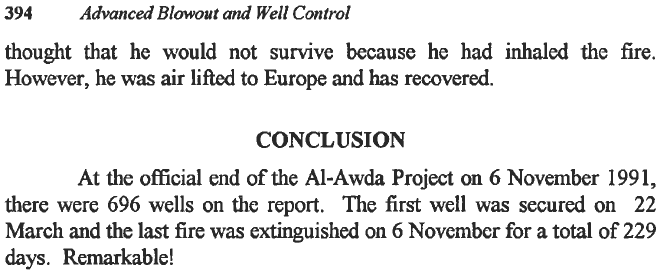
394
Advanced
Blowout
and Well Control
thought that he would not survive because he
had
inhaled the fire.
However, he was air
lifted
to Europe
and
has
recovered.
CONCLUSION
At the official end of the Al-Awda Project
on
6
November
1991,
there were
696
wells on the report.
The
first well was secured on
22
March
and
the last fire was extinguished on
6
Novembcr for
a
total of
229
days.
Remarkable!

Accumulator, 5,207
Alternative Classical Procedures
Constant Casing Pressure
-
Constant Drillpipe Pressure, 177
Low-Choke Pressure Method, 178
Overkill Wait and Weight
Method,
Reverse Circulation, 180-86
Annular Preventer, 4
Annulus Pressure Profiles, 154-1 77
Balance Point, 292
Barrel in
-
barrel out method, 29,38
See
Constant pit level mcthod
Bubble Point, 204
Bullheading, 2 19-28
Buoyancy, 288
Capping, 314
Causes of Well Kicks, 29-3 1
186
Gas cut mud, 30
Lost Circulation, 30
Mud weight lcss than formation
pressure, 29
While Tripping,
85
Charged Interval, 361
Choke, 16,23
55
Adjustments during Kill Procedure,
Cameron, 19
Drilling, 16, 19
Positive, 17
Production,
8,
17,18
SWACO Super, 19
Choke Line, 6-1
5
Choke Manifold, 16-24
Circulating out
the
Influx,
38-44
Circulating Pressure, 45
Method,
63
Determining for Wait and Weight
Classical
Procedures
Drill String Washout Effect, 144
Driller's
Method, 45-61
Floating and Subsea, 207
Plugged
Nozzle
Effect, 144
Wait and Weight Method, 61-83
Constant pit level method, 29
Continuous Coring, 194
Driller's Method, 45-48,83
Drilling Choke, 17-20
Ilynamic Kill, 256-67
Erosion, 20,25
Fire Fighting, 3 10
Fluid Dynamics
Bullheading, 219-28
Dynamic Kill, 256-67
Lubricating
-
Volumetric Kill, 228-
Momentum Kill, 267-76
Fluid-Type Determination, 147
Freezing,
3
1
7
Friction, 287
Kinetic, 287
Static, 287
Frictional Pressure
Loss,
150-54, 191,
194,256
Gas Expansion, 38
Header, 20-24
Hoses,
14,25
Hot Tap, 317
Hydraulic Snubbing Unit, 282
Influx
Migration,
1
19,195
Volumetric Procedure, 133
Kick Indicators, 31-32
Change in pump pressure, 3
1
Gas, oil, or water cut mud, 32
Increase in pit level, 3 1
Sudden increase in drilling rate, 3
1
56
Kill Rate, 49
Kill-Fluid Lubrication, 228-56
Lines
Choke, 6-15
Flare, 6,25
Flow,
7
Production,
8
Vent, 6
Magnetometer, 322
MAGRANGE,
322
Momentum, 269
of
Gas, 272
of Kill Fluid, 270
395
